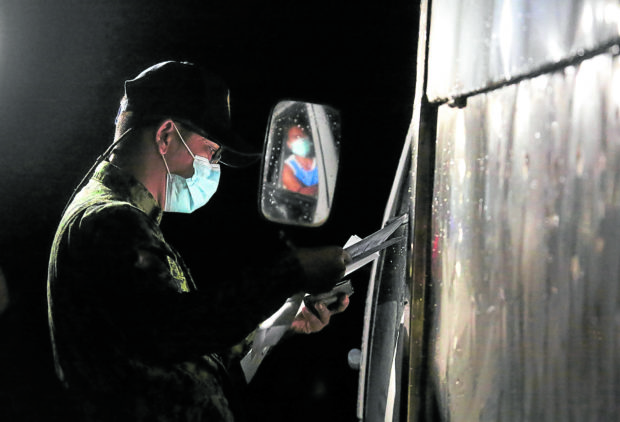
BORDER CONTROL A police officer checks the papers of a delivery van at a checkpoint on Sapang-Alat Bridge in Caloocan City before it could leave Metro Manila and enter Bulacan in the early hours of Friday, the start of the two-week enhanced community quarantine enforced in the capital region. —LYN RILLON
They say that third time’s the charm—but not for the Metro Manila public, despite experiencing total lockdown thrice since last year, with the government changing and adjusting its pandemic protocols.
On Friday, the first day of the two-week strictest enhanced community quarantine (ECQ), motorists and commuters entering and exiting the National Capital Region (NCR) bubble were greeted with long lines as police diligently stopped everybody to check if their trips were essential.
Gen. Guillermo Eleazar, chief of the Philippine National Police, inspected several checkpoints and was not surprised to see a lot of vehicles on the road.
“We see a lot of people are outside because our public transportation is operating [even at 50-percent capacity],” he said.
Maximum tolerance
The PNP was lenient as it allowed nonauthorized persons outside of residence (non-Apors) fetching worker Apors to pass through checkpoints.
“We give them an opportunity to secure the requirements that they will show to be able to pass the control points in Metro Manila,” he said.
Bowing to public pressure, the PNP made a turnaround on Thursday and allowed non-Apors to drive for Apors working in establishments permitted to operate during the lockdown.
Also allowed to pass intercity checkpoints were non-Apors fetching persons in the airport, those who have scheduled vaccination, those in medical emergencies and other “humanitarian reasons.”
The PNP chief ordered his men to exercise maximum tolerance in dealing with violators.
“We understand that the public may be experiencing quarantine burnout already, but it is very wrong to believe that these lockdowns have no effect,” Eleazar said.
18,000 police officers
NCR has been placed on lockdown from Aug. 6 to Aug. 20 to prevent the spread of the more infectious COVID-19 Delta variant.
Inside Metro Manila, the PNP deployed around 18,000 police officers to implement the lockdown: 1,203 at the 89 quarantine control points at the boundaries of NCR with the provinces of Cavite, Laguna, Rizal and Bulacan; 4,346 cops for implementing the curfew hours from 8 p.m. to 4 a.m.; 7,337 policemen at 2,745 vaccination sites; and 2,525 cops at quarantine sites.
Eleazar also ordered local police to set up a platoon or company-size quick-response teams to address crowding in vaccination centers.
“I have instructed all police chiefs to coordinate with local chief executives to determine the vaccination rules and process in their areas during the ECQ period,” Eleazar said.
Authorities blamed the outpouring of crowds in vaccination sites in Las Piñas, Manila and Antipolo to “fake news” on nonvaccinated individuals being prohibited from going out and being unable to receive cash aid from the government.